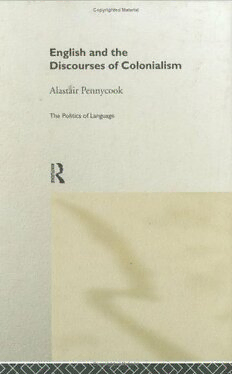
English and the Discourses of Colonialism PDF
252 Pages·1998·4.115 MB·English
Most books are stored in the elastic cloud where traffic is expensive. For this reason, we have a limit on daily download.
Preview English and the Discourses of Colonialism
Description:
If you're looking for a detailed study of the ways in which colonialism currently manifests itself in specific ELT methodology and in local contexts, this book will sorely disappoint. If, however, you seek a historical overview of colonialism's impact of the general field of ELT, this book will be of some use. In my own case, I referred to it for the literature review section of my dissertation not because I concur with most of his contentions but because he articulates the viewpoint of a small number of postmodern/colonialist critics of ELT theory and practice. For this reason, I give his book two stars--and perhaps because even academics who should know better need to be rewarded for their earnestness, if not their zealotry. What you will soon note about this book (as with all of Pennycook's major writings) is the degree to which he is willing to use anecdotal evidence and out-of-context quotations to prop up his criticism of the whole ELT enterprise. As one who is clearly enamored with postmodernism, Pennycook's selective application of evidence shouldn't surprise the reader. However, his willingness to ignore any evidence that clearly contradicts his claims is indefensible. Case in point: his relentless verbal assault on Mark Salzman, the author of "Iron and Silk." I was so amazed by Pennycook's commentary that I began to wonder if the book I'd read fifteen years ago was really as empathetic and endearing as I imagined. So I went back and reread it, sharing passages with Chinese friends, including one who made the author's acquaintance during the subsequent filming of his book. Pennycook would have the reader believe that Salzman is a hypocritical, callous-eyed colonialist when even a cursory (but open-minded) reading of his book indicates otherwise. I corresponded with Pennycook about my concerns and he was dismissive, saying that he had moved beyond that critique and had more important matters at hand. That may be, but one is still accountable for what one has published, especially in academic circles and especially considering that Salzman's book is one of the few that offers a genuine counter-discourse of colonialism in ELT. If you are planning to teach or conduct research into the phenomenon of ELT in China, you're better off packing "Iron and Silk" than this morose work.
See more
The list of books you might like
Most books are stored in the elastic cloud where traffic is expensive. For this reason, we have a limit on daily download.
